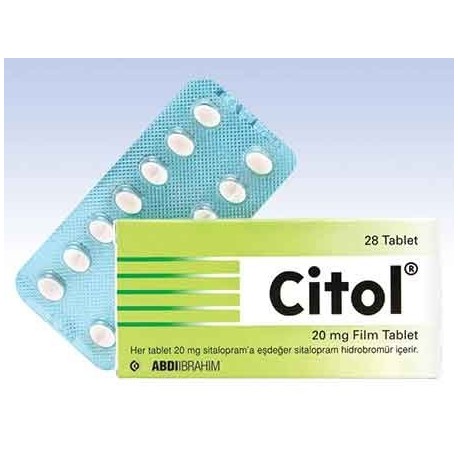 View larger
View larger Citol Citalopram (Generic Celexa) 28 Tablets
New product
BUY MORE PAY LESS
| Quantity | Discount | |
|---|---|---|
| 2 | 5% | |
| 3 | 10% | |
| 4 | 15% | |
| 5 | 20% |
Volume discounts
| Quantity | Discount | You Save |
|---|---|---|
| 2 | 5% | Up to $3.20 |
| 3 | 10% | Up to $9.60 |
| 4 | 15% | Up to $19.20 |
| 5 | 20% | Up to $32.00 |
More info
4. CLINICAL FEATURES
4.1. Therapeutic indications
Treatment of depression and prevention of relapse / recurrence,
Panic disorder with or without agoraphobia,
It is used in the treatments of Obsessive Compulsive Disorder (OCD).
4.2. Posology and method of administration
Posology / application frequency and duration:
Duration of treatment
Antidepressant effect is usually seen within 2-4 weeks. Since treatment with antidepressants is symptomatic, treatment should be continued for an appropriate period, usually 6 months, to prevent relapses after recovery. In patients with recurrent (unipolar) depression, maintenance therapy should be continued for several years to prevent new crises.
When used for the treatment of panic disorder, CITOL shows maximum effect after about 3 months and the response is maintained as long as the treatment is continued.
The onset of effect in OCD treatment takes 2-4 weeks, and recovery is seen over time.
Withdrawal symptoms seen on discontinuation of Selective Seretonin Reuptake Inhibitor (SSRT) therapy
Abrupt cessation of treatment should be avoided. When discontinuing citalopram, the dose should be reduced gradually over a period of at least 1 to 2 weeks to reduce the risk of withdrawal reactions (see sections 4.4 and 4.8). If intolerable symptoms occur following dose reduction or treatment discontinuation, continuing the previously prescribed dose may be considered. The doctor may then continue to reduce the dose at a slower rate.
Adults Depression treatment
CITOL is used orally as a single dose, 20 mg per day. Depending on the individual response of the patient, the dose can be increased to a maximum of 40 mg per day.
Panic disorder treatment
10 mg oral dose per day is recommended in the first week before increasing the daily dose of 20 mg. Depending on the individual response of the patient, the dose can be increased to a maximum of 40 mg per day.
OCD treatment
The recommended daily dose for the beginning is 20 mg. Depending on the individual response of the patient, the dose can be increased to a maximum of 40 mg per day.
Method of Application:
CITOL is used as a single daily dose. CITOL can be taken at any time of the day, regardless of food intake.
Additional information on special populations:
Kidney failure:
Dose adjustment is not required in patients with mild or moderate renal impairment. Caution is recommended in patients with severe renal impairment (creatinine clearance <30 ml / min, see section 5.2).
Liver failure:
In patients with mild or moderate hepatic impairment, a starting dose of 10 mg per day is recommended during the first two weeks of treatment. Depending on the individual response of the patient, the dose can be increased to a maximum of 20 mg per day. Caution and very careful dose titration is recommended in patients with severe hepatic impairment (see section 5.2).
Pediatric population (under 18 years of age):
CITOL should not be used in the treatment of children and adolescents under 18 years of age (see section 4.4).
Geriatric population (over 65 years of age):
In elderly patients, the dose should be reduced to half the recommended daily dose (eg 10-20 mg daily). The recommended dose for elderly patients is at most 20 mg per day.
Poor metabolisers for the CYP2C19 enzyme
In patients with poor metabolisers for the CYP2C19 enzyme, a starting dose of 10 mg per day is recommended during the first two weeks of treatment. Depending on individual patient response, the dose may be increased to 20 mg per day (see section 5.2).
4.3. Contraindications
Hypersensitivity to the active substance or to any of the excipients (see section 6.1).
Monoamine oxidase inhibitors (MAPI)
Citalopram should not be used in conjunction with an MAOI, including selegiline above 10mg per day. Citalopram should not be given until 14 days after discontinuing treatment with an irreversible MAOI, or until the end of the time specified in the instructions for use for this medicine after discontinuing treatment with a reversible MAOI. Treatment with MAOIs can be started 7 days after stopping citalopram treatment (see section 4.5).
Concomitant use of citalopram with linezolid is contraindicated when there is insufficient opportunity for close monitoring and monitoring of blood pressure.
Concomitant use with pimozide is contraindicated (see section 4.5).
Citalopram is contraindicated in patients with known prolonged QT interval or congenital prolonged QT syndrome.
Use of citalopram with other medicinal products known to prolong the QT interval is contraindicated (see section 4.5).
Film tablets contain lactose monohydrate. Patients who are intolerant to galactose, who have the Lapp lactase deficiency or who have poor glucose-galactose absorption should not use this drug.
4.4. Special use warnings and precautions
For treatment in elderly patients and patients with hepatic or renal impairment see section 4.2.

